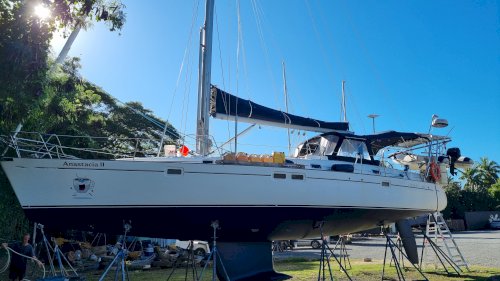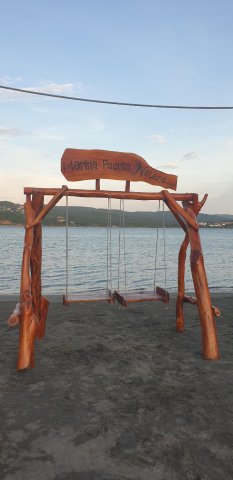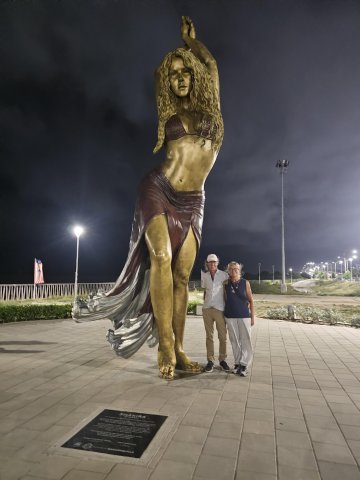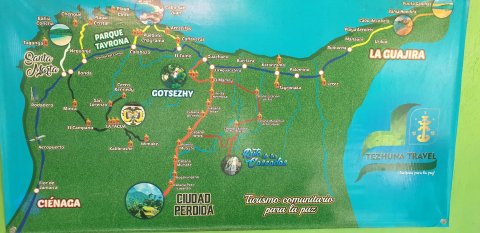
We sailed the 75 nautical miles from Curaçao without any problems. We had a tailwind all night and "old man sailing", a typical Christer's expression 😉 meaning slow-sailing with only the genoa/foresail up. In our case with the purpose not to arrive too early in the next morning.
Once we wriggled into the shallow industrial port where immigration and customs have their offices, we were able to clear into the country. This was followed by a thorough inspection of Anastacia where customs personnel boarded and looked through all the compartments to check that we were not trying to smuggle in anything inappropriate. Then we got the go-ahead to sail on to Surfside beach outside the capital Oranjenstad, where we could anchor. We then made the short stretch into a lagoon to the anchorage where we tried to find a good patch of sand to anchor at. The depth in the lagoon varies between 0 and 4 meters(!) and it took us three tries including a little ground-hitting in the soft seabottom before we found the right spot. The place was well protected from the waves but exposed to the wind as the island does not provide much wind protection. However, it suited us quite well to get some cooling air into the boat. 😊
The island is the western and smallest of the three ABC islands and shares much the same history. The Spanish called the islands "Islas inutiles", roughly "useless islands" and showed little interest in them. It also later became free for the Dutch to take over. The island is still part of the Kingdom of the Netherlands and the quest for total independence has been put on hold. It is estimated that the island has as many as 90 different nationalities and here they speak their own variant of Papiamento with stronger elements of Spanish than on Curaçao and Bonaire. Probably because of the proximity to Venezuela and Colombia and the language exchange from there. The island's economy is strong and is based almost entirely on tourism, which unfortunately also makes it the most exploited of the islands. A lady we spoke to in Oranjestad said that very little of Aruba's culture and history has been preserved to this day. As an example, she mentioned that almost none of the older houses from the colonial era remain in Oranjenstad, which was already founded at the end of the 18th century. She said that people who live here are not as happy as they used to be, due to the ongoing exploitation. The prices of most goods and services are higher than on, for example, Curaçao.
Sunny sandy beaches, gigantic hotels, parties and exclusive shopping probably sum up today's Aruba. A bit like St. Barth which we visited earlier this spring. However, we did our best to blend into the environment of the capital. We strolled the nice shopping streets, tasted Dutch waffles at The Dutch Pancakehouse and saw the movie Inside Out II at a cinema next door. Incidentally, the children in the salon looked at us wide-eyed when we old people took our seats. We then realized that we should have kidnapped some minor in town and taken them with us to get some legitimacy in the movie theater... However, we got the biggest reward when we visited the archaeological museum, which had a well-planned and educational exhibition about the history of the country and the nearby islands. Well worth a visit!
In various places in Oranjestad, you can find many real sized horse statues created by the artist Osaira Muyale. They symbolize a time during the 17th century, when the city was called Paardenbaj (horse bay). A place where horses were shipped from Venezuela and Colombia for breeding on the island and further trade. It is said that the ships anchored a little outside the island and the horses had to jump into the sea and swim to land.
We rented a car for two days to see a bit more of the island. Among other things, we drove through the small national park Arikok with fantastic heath-like areas full of cacti and lots of birds and lizards. There were also caves similar to those we saw in Curaçao with rock paintings from the early Caquetio Indians who lived here. Here we also saw bats that slept hanging from the ceiling of the cave. In the national park, as well as in some other places on the island, there were remnants of the gold mining that went on for a few decades at the end of the 19th and the beginning of the 20th century. However, the remains of mines, smelters, etc. were now in such poor condition that it was very difficult for us to get an image of what it had looked like. Everything was overgrown and many information boards had weathered away. Too bad, we thought. Although this was a short time in Aruba's history, this industry involved many people as well as mining companies from both the UK and the Netherlands.
We also visited small lagoons and a bridge created naturally by the erosion from the sea. To get to these places we had to drive on sand dunes and since it had recently rained there were small puddles here and there. Just in one such, slightly larger puddle in the middle of a track for four-wheelers, Christer had the pleasure of driving our rented little Kia Picanto. I (Malin) thought it looked very muddy and suggested that we could leave the car and walk the remaining few hundred meters to the place we wanted to visit. Christer took a more adventurous view of the whole thing and believed that we could safely get over this small obstacle. We had driven a bit off-road before without any problems... Of course, we got stuck instantly in the mud and the car's tires spanned easily and nicely with mud splashing in all directions. After a few fruitless attempts to get free, we received unexpected help from a Spanish family, also in a rented car, who happened to be driving by. The father engaged his sons and with everyone's strength the gentlemen managed to push the car out of the mud puddle. All those involved, including the car, were then thoroughly covered up. After a thousand politenesses and thanks, we could then drive on. I held back from commenting about the incident and refrained from such comments as "what did I tell you" and the like. However, I may have said a few words about manhood's unrealistic self-confidence and overconfidence in one's own ability...
A smaller town, Sint Nicolas is located on the eastern tip of the island. It is considered the island's city of culture, but unfortunately it was quite lifeless when we were there. The industrial history museum we intended to visit had closed, even though all the signs (and the website) said it would be open. A little disappointed, we found that the city probably only comes alive when it's carnival here. However, we were able to admire all the murals that adorned the buildings and made a short visit to Baby beach with resorts, pools, bathing tourists and restaurants…
The last stop was the small church, Alto Vista Kapel, which, in the tourist brochures, is depicted as the small chapel, located alone on the northwestern part of the island. Once we drove the small road to the church, however, we were met by an unlikely amount of people, four-wheelers, buses and cars mixed with souvenir stalls and food trucks. Somewhere in the crowd you could make out a small church. If you had thought of going to the place for a quiet contemplation, you would probably have had to think again. We turned around and instead drove back towards Oranjenstad and let the car get a much-needed wash.
Now we are preparing ourselves and Anastacia for sailing to Colombia. A country that we really look forward to visiting! We have organized all the certificates and documents that must be sent in advance to an agent before the visit. We have booked a berth in the marina Puerto Velero, just south of Barranquilla. The sailing there is supposed to take about 2.5 days and might not have required so much planning if it hadn't been for the thunderstorms that often pass through the area and different currents to take into account. We have also been warned to sail close to the coast where the Magdalena River flows out as it carries large amounts of logs and other debris into the sea which can pose a danger to boats. However, we will have a good tailwind and plan to sail between 20 and 50 nautical miles from land. Now we're just waiting for a good weather window to set off and trying to calculate an average speed that will allow us to pass the Magdalena river mouth when it's light and still arrive in port before it gets dark. We also need to take into account immigration and customs opening hours for clearance out from Aruba. We have been used to being allowed to stay in a country for up to 24 hours after clearance. In Aruba, you must leave the country immediately after clearance.
~~~~~~~~~~~~~~~~
Vi seglade de 75 sjömilen från Curaçao utan några problem. Vi hade medvind hela natten och ”gubbseglade”, ett typiskt Christer-uttryck 😉 som betyder att man slöseglar med bara genuan/förseglet uppe. Syftet var att inte komma fram för tidigt på morgonen.
När vi väl krånglat oss in till den grunda industrihamnen där immigration och tull har sina kontor kunde vi klarera in i landet. Därefter följde en noggrann inspektion av Anastacia där tullpersonal gick ombord och tittade igenom alla utrymmen för att kontrollera att vi inte försökte smuggla in något olämpligt. Sedan fick vi klartecken för att segla vidare till Surfside beach utanför huvudstaden Oranjenstad, där vi kunde ankra.
Vi tog oss sedan den korta sträckan in i en lagun till ankringsplatsen där vi försökte hitta en bra sandfläck att ankra vid. Djupet i lagunen varierar mellan 0 och 4 meter(!) och det tog oss tre försök inklusive en liten grundkänning i den mjuka botten innan vi hittade rätt. Platsen var väl skyddad för vågorna men utsatt för vinden då ön inte ger mycket vindskydd. Det passade oss dock rätt bra att få lite kylande luft in i båten. 😊
Ön är den västra och minsta av de tre ABC-öarna och delar ungefär samma historia. Spanjorerna kallade öarna för ”Islas inutiles”, ungefär ”värdelösa öar” och visade inget större intresse för dem. Det blev också senare fritt fram för holländarna att ta över. Ön är fortfarande en del av kungariket Nederländerna och strävan efter total självständighet har lagts på is. Man räknar med att ön har så mycket som 90 olika nationaliteter och här talar man en egen variant av Papiamento med starkare inslag av spanska än på Curaçao och Bonaire. Troligen på grund av närheten till Venezuela och Colombia och språkutbytet därifrån. Öns ekonomi är stark och bygger nästan helt på turism vilket tyvärr också gör den till den mest exploaterade av öarna. En dam vi talade med i Oranjestad menade att väldigt lite av Arubas kultur och historia har bevarats till idag. Som exempel nämnde hon att nästan inga av de äldre husen från kolonialtiden finns kvar i Oranjenstad som grundades redan på slutet av 1700-talet. Hon menade att människor som bor här är inte lika gladdlynta längre, jämfört med tidigare, på grund av den pågående exploateringen. Priserna på de flesta varor och tjänster är högre än på exempelvis Curaçao.
Soliga sandstränder, gigantiska hotellkomplex, party och exklusiv shopping sammanfattar nog dagens Aruba. Lite som St. Barth som vi besökte tidigare i vår. Vi gjorde dock vårt bästa för att smälta in i huvudstadens miljö. Vi flanerade vi på de fina shoppinggatorna, smakade på holländska våfflor på The Dutch Pancakehouse och såg filmen Inside Out II på en biograf intill. Barnen i salongen tittade för övrigt storögt på oss när vi gamlingar satte oss på våra platser. Vi insåg då att vi borde kidnappat någon underårig på stan och tagit med oss för att få lite legitimitet i biosalongen… Största behållningen fick vi dock när vi besökte arkeologiska museet som hade en välplanerad och lärorik utställning om landets och de näraliggande öarnas historia. Väl värt ett besök!
På olika platser i Oranjestad hittar man många häststatyer i naturlig storlek skapade av konstnären Osaira Muyale. De symboliserar en tid under 1600-talet, då staden kallades Paardenbaj (hästviken). En plats dit hästar skeppades från venezuela och Colombia för uppfödning på ön och vidare handel. Det sägs att fartygen ankrade en bit utanför ön och hästarna fick hoppa i havet och simma till land.
Vi hyrde bil i två dagar för att se lite mer av ön. Bl a körde vi igenom den lilla nationalparken Arikok med fantastiska hedliknande områden fullt av kaktusar och massor av fåglar och ödlor, Här fanns också grottor liknande dem vi sett i Curaçao med hällmålningar från de tidiga Caquetio-indianerna som bott här. Här såg vi även fladdermöss som sov hängandes i grottans tak. I nationalparken liksom på några andra platser på ön fanns rester av den guldutvinning som pågick under några få decennier i slutet av 1800 och början av 1900-talet. Resterna av gruvor, smältverk m m var dock nu i så dåligt skick att det var väldigt svårt för oss att skapa oss en bild av hur det hade sett ut. Allt var igenvuxet och många informationstavlor hade vittrat bort. Synd, tyckte vi. Även om detta utgjorde en kort tid i Arubas historia hade den här industrin involverat många människor liksom gruvbolag från både Storbritannien och Nederländerna.
Vi besökte också små laguner och en bro som skapats naturligt av erosionen från havet. För att komma till dessa platser fick vi köra på sanddyner och eftersom det nyligen regnat låg det små vattenpölar här och var. Just i en sådan, lite större pöl mitt i en bana för fyrhjulingar, fick Christer för sig att köra med vår hyrda lilla Kia Picanto. Jag (Malin) tyckte att det såg väl lerigt ut och menade på att vi gott kunde lämna bilen och gå de få hundra meter som var kvar till platsen vi ville besöka. Christer såg mer äventyrligt på det hela och menade att vi tryggt kunde ta oss över detta lilla hinder. Vi hade ju kört lite offroad tidigare utan problem… Naturligtvis fastande vi direkt i leran och bilens däck spann lätt och fint med lera skvättandes åt alla håll. Efter några fruktlösa försök att komma loss fick vi oväntad hjälp från en spansk familj, även de i hyrd bil, som råkade köra förbi. Pappan engagerade sina söner och med allas kraft lyckades herrarna knuffa upp bilen från lerpölen. Samtliga involverade, inklusive bil, var därefter duktigt nersölade. Efter tusen artigheter och tackande kunde vi sedan köra vidare, Jag drog mig för att dra upp något mer om händelsen och avstod från sådana kommentarer som ”vad var det jag sa” och liknande. Jag kan dock ha sagt några ord om manlighetens orealistiska självförtroende och överdrivna tillit på den egen förmågan…
En mindre stad, Sint Nicolas ligger på öns östra spets. Den räknas som öns kulturstad men tyvärr var det ganska dött när vi var där. Det industrihistoriska museum som vi tänkt besöka hade stängt, trots att det på alla skyltar (och webbplatsen) stod att det skulle vara öppet. Lite besvikna konstaterade vi att staden förmodligen bara lever upp när det är karneval här. Vi kunde dock beundra alla väggmålningar som prydde byggnaderna och gjorde ett kort besök på Baby beach med resorter, pooler, badande turister och restauranger…
Sista anhalten blev den lilla kyrkan, Alto Vista Kapel som, i turistbroschyrerna, utmålats som det lilla kapellet, ensligt beläget på öns nordvästra del. När vi väl kört den lilla vägen fram till kyrkan möttes vi dock av en osannolik mängd människor, fyrhjulingar, bussar och bilar blandat med souvenirstånd och food trucks. Någonstans där i vimlet kunde man skönja en liten kyrka. Om man till äventyrs hade tänkt ta sig till platsen för en stilla kontemplation så hade man nog fått tänka om. Vi vände och körde istället tillbaka mot Oranjenstad och lät bilen få en välbehövlig tvätt.
Nu förbereder vi oss och Anastacia för segling till Colombia. Ett land som vi verkligen ser fram emot att få besöka! Vi har tagit fram alla de intyg och dokument som skall skickas i förväg till en agent inför besöket. Vi har bokat plats i marinan Puerto Velero strax söder om Barranquilla. Seglatsen dit lär ta ca 2,5 dygn och hade kanske inte krävt så mycket planering om det inte hade varit för de åskoväder som ofta drar förbi i området och olika strömmar att ta hänsyn till. Vi har också blivit varnade för att segla nära kusten där floden Magdalena rinner ut då den tar med sig stora mängder stockar och annat skräp ut i havet och som kan utgöra fara för båtar. Vi kommer dock att ha bra medvind och planerar att segla mellan 20 och 50 sjömil från land. Nu väntar vi bara på ett bra väderfönster för att kunna ge oss iväg och försöker räkna på en medelfart som ger oss möjlighet att passera Magdalenas mynning när det är ljust och ändå komma i hamn innan det blir mörkt. Vi behöver också ta hänsyn till öppettiderna för immigration och tull för utklarering från Aruba. Vi har varit vana vid att man får stanna upp till ett dygn i ett land efter utklarering. I Aruba gäller att man omedelbart måste lämna landet efter utklarering.
Oranjenstad





Beaches and resorts




Arikok national park with bat caves






Natural bridge

Remains of goldmines and smelters, different locations



Sint Nicolas and surroundings




Alto Vista Kapel




























7 Commentaire(s)
Vilken färgstark ö, mycket intressant. Tack för berättelsen! Lycka till på nästa etapp!
28 July 2024 Answer🥰
28 July 2024 AnswerNi upplever verkligen varje ställe ni besöker. Härligt ! Break a leg 😍
29 July 2024 AnswerVi försöker 😊
03 August 2024 Answer👍😎⛵️spännande, hur får ni info om väder, strömmar etc, några speciella informationskanaler? Tidvatten förekommer de i de farvatten som ni nu är i
30 July 2024 AnswerHej Sven! Vi använder huvudsakligen PredictWind som källa, men även lokala prognoser. Sen är det sällan som prognoserna stämmer när det gäller mindre variationer i vädret. Tidvattnet är i princip obefintligt här i Karibien men det blir mer av det efter Panama.
03 August 2024 AnswerÄnnu en stund härlig läsning o många skratt!! Biobesöket o ert äventyr på stranden med hyrbilen som körde fast - så klart 😂😂. Lennart undrade vad jag läste för bok som var så rolig att jag skrattade högt. Ingen bok men Malin 🤗 Härliga bilder o mycket intressant läsning om öns historia. Hoppas seglingen till Colombia går fint. Ser redan fram emot nästa rapport Kram
04 August 2024 Answer